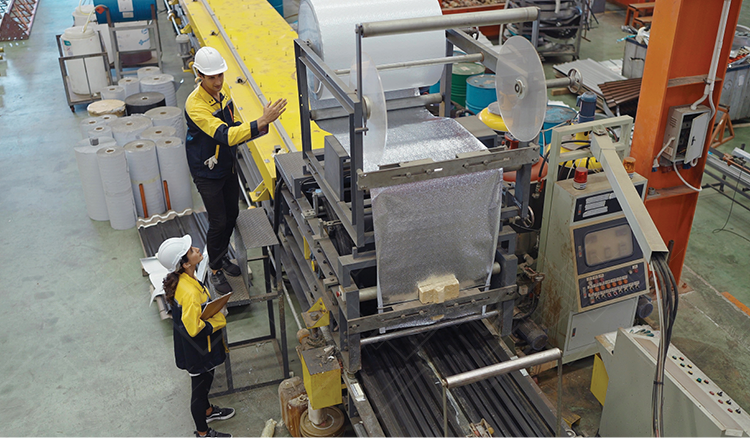Guiding the Path Forward for U.S. Semiconductor Manufacturing | How Veryable Can Offer Support
Throughout the United States, considerable amounts of public and private funds are being directed towards the emerging semiconductor chip sector. Prompted by the bipartisan CHIPS and Science Act passed last year, both the industry and the government are collaborating closely to enhance domestic manufacturing. This effort aims to secure a foothold in a future-oriented industry and ensure a dependable domestic supply of these vital components, especially amidst escalating tensions with China and growing concerns about Taiwan's autonomy. Despite the substantial influx of public and private investments, challenges persist in establishing a homegrown semiconductor industry. These challenges encompass setbacks like regulatory delays, gaps in the labor market, and disruptions in the supply chain driven by geopolitical factors. The outcome of this industry's endeavors could yield extensive implications for American enterprises and individuals, influencing various aspects ranging from the technology job market and the availability of electronics to the economic trajectory of the emerging industrial region.
Aspirations for a Domestic Semiconductor Manufacturing Sector
Semiconductor chips, compact electrical circuits primarily crafted from silicon, stand as indispensable elements within nearly all contemporary electronics – ranging from mobile phones and household appliances to automobiles. Beyond their commercial applications, these chips hold paramount significance for America's national security, with the Defense Department necessitating approximately 1.9 billion of them annually. For the better part of the post-1990s era, the semiconductor chip manufacturing sector has remained predominantly concentrated in Asia, with the most advanced chips originating from Taiwan. As geopolitical tensions escalated between the United States and China, concerns over the security of the semiconductor supply chain surged. This prompted the Biden administration to embark on an ambitious initiative aimed at cultivating a domestic semiconductor chip manufacturing industry.
In addition to fortifying the supply chain's reliability, a domestically grown chip industry is poised to invigorate the economy. It would contribute to the resurgence of high-tech manufacturing that the Biden administration seeks to nurture, potentially generating around 40,000 new job opportunities. To incentivize local production, the Biden administration has provided more than $76 billion in grants, tax incentives, and other forms of financial support. On the corporate front, upwards of 35 companies have committed $210 billion to chip-related manufacturing ventures since 2020, as reported by the Semiconductor Industry Association. These investments could propel the U.S. market share to reach as high as 14% by 2030.
Obstacles on the Home Front
Despite earnest endeavors, the journey toward cultivating a thriving domestic chip industry encounters impediments. Apprehension is mounting among industry experts that challenges stemming from bureaucratic hurdles, the labor market, and disruptions in the global market could imperil the United States' aspirations to become a significant contender in the worldwide chip arena. Certain critics cast doubt upon the nation's capacity to sustain competitiveness within a well-established global market, owing to heightened barriers for initiating new manufacturing facilities in the U.S. According to a Bloomberg analysis, the period required to establish a fresh chip fabrication plant in the U.S. grew by 38% from 1990 to 2020, attributed to the introduction of new prerequisites like Clean Air Act certification (conversely, some argue that these new mandates render these plants more durable and preferable compared to less meticulously constructed rivals).
As discussed in one of my previous blogs (see "Revolutionizing Manufacturing: How Veryable's Innovative Labor Solution is Reshaping Talent Acquisition and Retention"), finding enough workers to fill new jobs in manufacturing is a serious worry. Specifically, the semiconductor industry has struggled to hire for years, in part due to too few students entering the relevant academic fields, and the new boom will also contend with the tightest labor market in years.
Research conducted by consulting firms has predicted a deficiency of 70,000 to 90,000 workers in the industry. This shortage surpasses the expected number of new positions resulting from recent investments and highlights a more significant issue in semiconductor recruitment. This serves as a small example of the larger labor shortage predicament in manufacturing, which, according to a study by Deloitte and The Manufacturing Institute, might lead to a shortfall of 2.1 million vacant positions by 2030.Several chipmakers and universities have proposed large budgets to spur educational investments and candidate training: Intel has allocated $100 million for universities, community colleges and other technical programs, while Purdue University has pledged to graduate 1,000 new engineers every year.[1] Even if successful, the first few years of the U.S. semiconductor industry will feel the labor market pains.
Global Dynamics: Chips and the Trade War
As the United States seeks to establish a robust domestic semiconductor industry, it does so against the backdrop of a tense global trade environment. The ongoing trade war between the U.S. and China, coupled with concerns about Taiwan's autonomy, adds complexity to the equation. Export restrictions, supply chain disruptions, and geopolitical maneuvering all have the potential to impact the semiconductor market, causing ripples throughout the economy.
The cost of this trade war could be steep, affecting not only businesses and manufacturers but also consumers who rely on electronic devices. The automotive industry, in particular, has already felt the pinch as chip shortages led to production slowdowns and increased costs.
Misconceptions About the Workforce
The semiconductor industry is relatively a niche and some roles require extensive knowledge of science, math, and technology. However, over 60% of individuals engaged in semiconductor manufacturing lack such educational backgrounds.In essence, the industry offers numerous valuable opportunities for blue-collar workers, enabling them to acquire expertise and secure a livelihood to support their families. Conventional portrayal of laboratory technicians meticulously constructing microchips with automated accuracy falls short of capturing the diverse array of roles necessary to enhance a nation's prowess in semiconductor manufacturing.
The Way of Veryable - Accelerating U.S. Semiconductor Advancement
To tackle these challenges and position the U.S. at the forefront of the global semiconductor market, a multifaceted strategy is imperative. While boosting awareness and allocating more funds to education are crucial steps, they alone won't suffice to solve the workforce scarcity. The Veryable on-demand labor platform can play a pivotal role by granting access to a pool of Operators who are prepared to tackle daily challenges. This approach enables the creation of a flexible labor pools that can be trained and diversified to handle fluctuations in demand. Operators within Veryable's platform actively seek opportunities that challenge them and offer incentives, aligning perfectly with the semiconductor industry's growth trajectory. Embracing this model can simultaneously address the immediate labor deficit and establish a pathway for individuals from varied backgrounds to enter the industry and flourish.
Veryable's platform acts as a bridge connecting manufacturers with skilled operators available for flexible assignments. This empowers manufacturers to swiftly adapt to shifting production requirements without committing to permanent hiring. For the semiconductor sector, this translates to the capability to expand operations during peak periods and effectively manage demand fluctuations. It also opens doors for individuals to participate in the industry, even if they lack a conventional background in science, technology, engineering, or mathematics (as mentioned above, there are many available jobs that don't require an engineering degree from Purdue).
Moreover, the Veryable platform facilitates opportunities for upskilling and cross-training. As the semiconductor field evolves, having a workforce that can learn and adopt new skills becomes paramount. Veryable's model empowers workers to gain proficiency in various manufacturing facets, broadening their skill sets and rendering them more valuable contributors to the industry. This not only addresses the scarcity of labor but also cultivates a more resilient and versatile workforce.
Conclusion
Successfully entering domestic semiconductor chip production could turbocharge the new U.S. manufacturing surge, creating well-paid jobs and manufacturing hubs beyond traditional tech centers. This move would secure the U.S. chip supply, shielding consumers from electronics shortages and price spikes. However, achieving this requires more than increased funding for education and training. It demands adaptable, tech-driven strategies to address workforce shortages. It demands Veryable's on-demand labor platform. Nevertheless, the U.S.-China trade conflict driven by protectionism and security-based constraints will persist, impacting the global economy until supply chains are insulated. The pursuit of technological components, vital minerals, and intellectual property is already reshaping the U.S. economy, with the semiconductor sector emblematic of these changes.
Previous Posts
How Policy Constraints, Not Just Production Bottlenecks, Threaten Your Bottom Line
The Future of Manufacturing and Logistics
Create a free business profile today to explore our platform.





